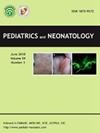Preterm birth increases cerebral palsy hazards in children of mothers with chronic hypertension in pregnancy
IF 2.3
4区 医学
Q2 PEDIATRICS
引用次数: 0
Abstract
Background
Children of mothers with chronic-hypertension in pregnancy have high rates of preterm-birth (<37 weeks of gestation) and small-for-gestational-age (SGA), both of which are risk factors of cerebral palsy (CP). This study investigated the cumulative risks of CP in children exposed to maternal chronic-hypertension vs. other types of hypertensive-disorders-of-pregnancy (HDP), and whether preterm-birth and SGA potentiate the antenatal impact of chronic-hypertension to increase CP hazards.
Methods
This population-based cohort study enrolled 1,417,373 mother-child pairs with singleton live births between 2004 and 2011 from the Taiwan Maternal and Child Health Database. A total of 19,457 pairs with HDP were identified and propensity-score-matched with 97,285 normotensive controls. Children were followed up for CP outcome until age 6–13 years. HDP were classified into chronic-hypertension, gestational-hypertension, preeclampsia, and preeclampsia-with-chronic-hypertension. Using the normotensive group as the reference, the associations between chronic-hypertension and CP hazard were assessed with adjusted hazard ratios (HR) and 95% confidence intervals (CI) in Cox proportional hazards regression models, and the effects of preterm-birth and SGA on the associations were examined.
Results
The HDP group had higher rates of CP (0.8%) than the normotensive group (0.5%), particularly the subgroup of preeclampsia-with-chronic-hypertension (1.0%), followed by preeclampsia (0.9%), chronic-hypertension (0.7%) and gestational-hypertension (0.6%). Preterm-birth, but not SGA, exerted moderating effects to increase CP risks in children exposed to maternal chronic-hypertension. Before adjustments, chronic-hypertension alone had no substantial contribution to CP hazard (HR 1.35, 95% CI 1.00–1.83), while preeclampsia alone (1.64, 1.28–2.11) or with superimposed-chronic-hypertension (1.83, 1.16–2.89) had significant effects. After including preterm-birth in the multivariable model, the CP hazard for chronic-hypertension alone rather than other types of HDP was raised and became significant (1.56, 1.15–2.12), and the significance remained after stepwise adjustments in the final model (1.74, 1.16–2.60).
Conclusions
Preterm-birth might potentiate CP hazards in children of mothers with chronic-hypertension in pregnancy.
早产会增加妊娠期慢性高血压母亲所生子女患脑瘫的风险。
背景:妊娠期患有慢性高血压的母亲,其子女的早产率很高(方法:这项基于人群的队列研究从台湾妇幼保健数据库中收集了 2004 年至 2011 年间单胎活产的 1,417,373 对母子。共识别出 19,457 对患有 HDP 的母婴,并与 97,285 例血压正常的对照组进行了倾向得分匹配。对患儿的 CP 结果进行了随访,直至其 6-13 岁。HDP分为慢性高血压、妊娠高血压、子痫前期和子痫前期合并慢性高血压。以血压正常组为参照,在Cox比例危险回归模型中用调整后的危险比(HR)和95%置信区间(CI)评估慢性高血压与CP危险之间的关联,并考察早产和SGA对关联的影响:HDP组CP发病率(0.8%)高于血压正常组(0.5%),尤其是子痫前期合并慢性高血压亚组(1.0%),其次是子痫前期(0.9%)、慢性高血压(0.7%)和妊娠高血压(0.6%)。早产(而非 SGA)具有调节作用,可增加母亲患慢性高血压的儿童患先天性心脏病的风险。在进行调整之前,单独的慢性高血压对CP风险没有实质性影响(HR 1.35,95% CI 1.00-1.83),而单独的子痫前期(1.64,1.28-2.11)或叠加慢性高血压(1.83,1.16-2.89)则有显著影响。将早产纳入多变量模型后,单纯慢性高血压而非其他类型 HDP 的 CP 危险性升高并变得显著(1.56,1.15-2.12),在最终模型中经过逐步调整后,其显著性仍然存在(1.74,1.16-2.60):早产可能会加剧妊娠期慢性高血压母亲所生子女的CP危害。
本文章由计算机程序翻译,如有差异,请以英文原文为准。
求助全文
约1分钟内获得全文
求助全文
来源期刊

Pediatrics and Neonatology
PEDIATRICS-
CiteScore
3.10
自引率
0.00%
发文量
170
审稿时长
48 days
期刊介绍:
Pediatrics and Neonatology is the official peer-reviewed publication of the Taiwan Pediatric Association and The Society of Neonatology ROC, and is indexed in EMBASE and SCOPUS. Articles on clinical and laboratory research in pediatrics and related fields are eligible for consideration.
 求助内容:
求助内容: 应助结果提醒方式:
应助结果提醒方式:


